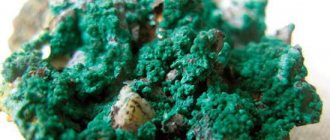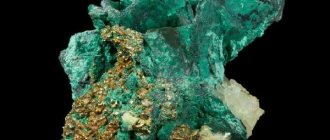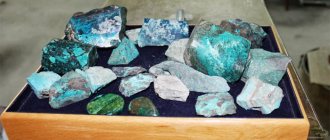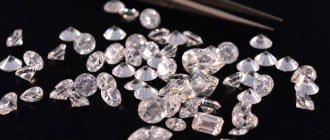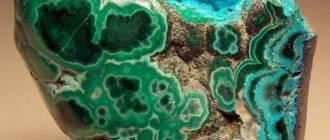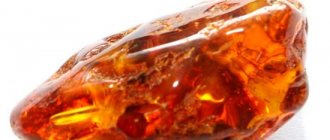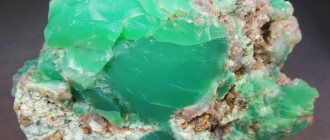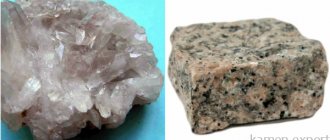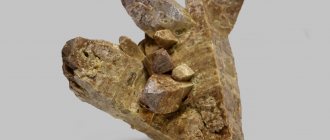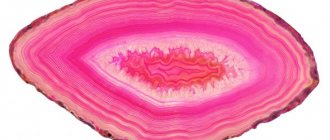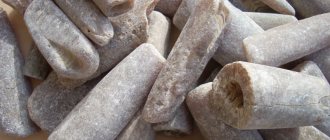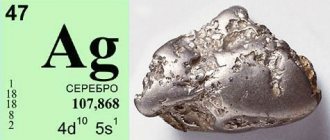There is an ancient legend: if you press the malachite stone to your body, you can become invisible and learn to understand the language of animals.
No other mineral on earth has such magical characteristics.
In addition to its magical and healing properties, the green patterned gem is one of the most beautiful and popular in the world: it is used to make real works of art, unique jewelry, and was used for the interior decoration of palaces.
We’ll take a closer look at other characteristics in this article.
What is this stone?
What it looks like, photo:
Russia was one of the first to start mining malachite on an industrial scale. Not only jewelry and interior decoration of palaces, but also copper were made from it.
There were many names. Malachite was especially often called curly or peacock stone for its patterning and play of green shades.
The Ural mines are the place where malachite was mined in Rus', where it was processed, producing amazingly beautiful mosaics, vases, and boxes.
Bazhov’s work “Malachite Box” is the hallmark of magical malachite. Semi-precious or ornamental stone belongs to copper ores, since it contains the highest percentage of copper.
Malachite Box
Common in areas of oxidation of copper deposits.
The surface of the gem is a non-repeating pattern: waves, shade transitions, stains, “eyes”, dark rings, stripes.
Malachite deposits are often the predecessors of copper ore deposits. Its “neighbor” is considered to be azurite, which, according to observations, subsequently also turns into malachite.
Previously, the mineral was very expensive and was considered precious. There are quite a lot of deposits of it, so the price is relatively low.
Nowadays it is actively used in jewelry and stone cutting, and is presented as a gift at government receptions.
The end of the malachite era
At the end of the 19th century, this delightful mineral became available not only to very wealthy people, but also to nobles. Competitions regarding the number of malachite items in homes have ceased, and the mineral has become less used in interiors. Malachite began to be used to make paint that covered the roofs of houses.
The revolution of 1917 led to the fact that stone mining decreased significantly. This was due to the fact that the two main deposits - Mednorudnyanskoye and Gumeshevskoye - were severely depleted. At the end of the 19th century, the Gumeshevskaya mine was seriously flooded. That’s why now this place is visited exclusively by extreme sports enthusiasts. The Mednorudnyanskoe deposit is still functioning, but it is not malachite that is mined here, but copper ore. Today, Ural malachite is practically never found here, and therefore is valued more and more.
Origin story
Photo of unprocessed malachite:
The first deposits date back more than 6 thousand years and are located in Africa (north and central part).
It is known that stone was originally used to make tools. And only then they began to use it in jewelry.
Malachite also served as a source of copper mining.
Different countries have their own stories about the charming and mysterious malachite:
- The gem was especially revered in Ancient Egypt. It was believed that he was a symbol of the goddess Hathor, who brought fertility to people and was responsible for female attractiveness and happiness in family life. In Rome - the goddess Venus.
- In India, malachite is considered a stone that can completely cleanse the subtle bodies and energy centers (chakras) of a person.
Malachite began to be used as jewelry already during the Middle Ages. Then other methods of copper mining were invented, and large deposits in Europe began to deplete.
Not only decorations, but also the mosaic method of decorating interior decoration (tables, columns, doors) gained popularity.
The Russian mosaic method, reminiscent of lace, opened up new possibilities for using stone. Thin plates, when connected, formed enchanting patterns.
Wall panels, vases and boxes were also created. However, there are very few objects in the world carved from solid pieces of malachite, since large sizes are not typical for the mineral.
But even small fragments have viscosity and softness, which makes malachite one of the most convenient stones for processing.
The style of Russian mosaic became known far beyond Russia, starting in the 1830s. It was then that Demidov, a Russian industrialist involved in stone mining, introduced amazing malachite products to a wide range of people.
Tabletop made using Russian mosaic technique. Ural Geological Museum.
And the exhibition, held in 1850, made the mineral worldwide popular as a jewelry stone, used for interior decoration and the manufacture of luxury items.
In mineralogy, malachite officially received its place in 1747 thanks to a scientist from Sweden.
Over time, samples of malachite of lower quality began to be used to obtain turquoise-colored paint. It was used to paint the roofs of houses, the outer parts of buildings, and was used in painting.
Malachite case today
The Urals are far from the only place in the world where malachite deposits have been discovered. Development is also underway in Altai. By the way, sometimes there are samples of Altai malachite, which in terms of beauty and fancy rings are practically no different from samples of the Ural mineral. The modern leader in the supply of malachite is the Republic of Congo. The malachite mined here differs from the Ural one in its pattern, consisting of even stripes. The mineral is mined in the UK, Chile, Australia, France and Cuba. However, the stones mined in these mines are significantly inferior in their external qualities to Ural malachite.
Meaning
There are still disputes between mineralogists from different countries about the origin of the name of the stone.
There are several most famous versions:
- Malachite comes from the Greek. μολόχη - poplar, mallow, by analogy with patterned designs with plant leaves.
- The name was obtained due to the softness of the mineral, derived from the Greek word malakos - soft.
- In ancient times in Rus' and in the Middle Ages, the Latin name “Molochites” was used, which had a synonymous form “Murrin”.
- Until the 18th century among pundits it was customary to call malachite melochiles, melochites, molochites (from the Latin). Mineralogist from Sweden Valery suggested calling it “Malachite”.
- On the territory of Russia for a long time (until the 19th century) the mineral was called “Malakhid” and “Malakid”. And the popular names are curly stone, peacock eye and velvet ore.
Jewelry value
The color palette of malachite stone ranges from greenish to dark green (“plush” color).
There are two types of mineral:
- jewelry - turquoise with a striped-rounded pattern; Stones from the Congo “peacock eye” are considered valuable: blue-green with circles coming from the center;
- decorative – striped corduroy, silky; Ural malachite is characterized by alternating dark and light green areas, separated by lines of contrasting shades.
A variety of malachite is “peacock eye.”
The jewelry variety is equated to semi-precious minerals and is used for jewelry.
Physical properties
The famous green tones are given to the stone by copper, the amount of which can reach at least 57% (Cu). And additional colors are obtained from the admixture of iron. CO2 (carbon dioxide) – 19.9%, H2O (oxygen) – 8.2%,
The mineral is very easy to scratch and break. It is soluble in acids and releases carbon dioxide in this process.
Distinctive characteristics are low hardness and viscosity, which simplify processing.
The original name in science is copper bicarbonate.
Characteristics:
| Chemical formula | Cu2CO3(OH)2 |
| Impurities | Fe (iron) |
| Color, trait | All shades of green, starting from bluish-turquoise and ending with saturated tones, the brightness depends on the density. |
| Shine | Matte, the crystals have a glassy appearance, if aggregates or fine-fiber crystals, then silky, “velvet”. |
| Cleavage | Perfect |
| Mohs hardness | 3,5 – 4 |
| Density | 3.75 - 3.95 g/cm3 |
| Kink | Splintered, shell-like |
| singonia | Monoclinic |
| Transparency | Not transparent |
| Refractive index | 1,656 – 1,909 |
The structure of the crystals is needle-like, prismatic or lamellar. If there is a mechanical impact, the crystals take on a spherical or dendroid shape.
It melts due to high temperature. It is very difficult to find well-formed crystals: they are generally small and rare.
Chemical composition
Contains: Copper oxide CuO - 71.59% (Cu - 57.4%), carbon dioxide (CO2) 19.90%, water (H20) 8.15%.
Natural malachites usually meet this composition. CaO, Fe2O3, SiO2, etc. are also found in very small quantities. Their presence is obviously due to adsorbed or mechanical impurities of foreign substances.
Varieties
1. Copper green - earthy soft malachite.
Crystallographic characteristics
Monoclinic system
Symmetry class. Prismatic 2/m? V. With. Etc. gr. P21/a(C 52h). a0 = 9.49; b0 = 12.00; с0 = 3.24, β = 98°42′. Axle ratio. 0.788: 1: 0.274; Z = 4.
The main forms of crystals are a {100}, m {110}, b {010} and p {201}.
Malachite. Kidney-shaped aggregate. Zaire
Field
Previously, malachite was mined in huge quantities in Russia (until 1917). Now the reserves are almost exhausted; small amounts of mining remain on Lake Baikal.
Gemstones from the Korovinsko-Reshetnikovskoe deposit and Altai are also supplied.
The most active production and export is carried out in the Congo. The stones from there have a characteristic bright pattern and cylindrical design.
There are several other deposits in the world, but not so large:
- France;
- Germany;
- Kazakhstan;
- England (County Cornwall);
- Australia;
- Italy;
- Namibia;
- Chile.
African malachite
African malachite has bright shades and alternating light and dark stripes of green color, which makes the stone original with a spectacular color scheme.
Origin of malachite and its deposits
In terms of its chemical composition, malachite is a fairly simple compound - the basic copper salt of carbonic acid (or the basic anhydrous copper carbonate). Among copper compounds, malachite is one of the most stable minerals, because under the influence of moisture and carbon dioxide, the remaining copper compounds gradually turn into green malachite. Even ancient copper or bronze items are often covered with a green coating, consisting mainly of malachite...
Tagil malachite (stone from the collection of the Malachite Box store)
In nature, malachite is formed in the oxidation zone - in the weathering crust of copper ores occurring in limestones or dolomite and calcareous shales. Chemically strong underground waters permeate the copper pyrite, destroy it and take away its copper, combining it with carbonic acid from neighboring limestones. Dissolved minerals leave pores and voids in the rock, which malachite does not always fill completely and creates a bizarre spongy kidney-shaped surface. The different shades of green color of malachite depend on the inclusion of other minerals: chrysocolla, asperolite, elite, etc. For example, chrysocolla gives a bluish tint. The mystery of the birth of the bizarre malachite pattern was studied for a long time by Leningrad professor D.P. Grigoriev. He was especially interested in the process of creating spherulites (buds) with an internal radial-ray structure. In laboratory conditions, D. P. Grigoriev observed under a microscope a crystallization process similar to the origin of malachite. And this is the picture that appeared before his eyes. ...At the uneven edge of the preparation, small spherulites still appeared... As soon as any two neighboring balls, when their rays are spreading in all directions, come into contact, a platform is formed between them, outwardly similar to the one that occurs between balls pressed to each other. From this moment, during the group growth of spherulites, an inexorable mineralogical law comes into force, which determines the fate of each of the spherulites. Through a microscope you can see how the growing spherulites compete for the necessary space and crowd each other out. Some of them freely spread their rays, like a fan, others are limited in growth and sooner or later are caught by their closest neighbors. And, as a result, a crystalline crust is obtained with an internal radiant structure of many centers and an external surface composed of parts of various spheres. Grigoriev believes that, along with radiance, the successive layers observed in malachite buds depend on fluctuations in the rate of entry of dissolved copper carbon dioxide salt into the cavity of the growing spherulites. Moreover, the rays in them can be so thin that they cannot be distinguished by the naked eye, and then the malachite outwardly appears only layered, concentrically banded, without a radiant structure... It was with such observations and research that the creation of artificial malachite began. Today, the synthesis of a wonderful green stone has already emerged from the walls of the crystallography laboratory of Leningrad University, and in the Sverdlovsk association “Ural Gems” an industrial installation of artificial malachite is already operating, and the first products have been created from it. Malachite was also synthesized at the All-Union Research Institute of Mineral Raw Materials. Artificial malachite has a uniform density, a green silky shine after polishing, and has no pores or cavities at all... And yet, in the synthesis of this stone, man is still far behind nature in creative imagination. For natural malachite is much richer than artificial malachite in the variety of green shades and tints, and especially in the intricacy and whimsicality of patterns and designs. Now let’s talk about the main Ural deposits of malachite. It is in the Urals that the world’s richest deposits of the best decorative green stone are located... “Excuse me, excuse me,” another reader may say, “what richest deposits of Ural malachite can we talk about today?” Yes, there was once a famous malachite era, grandiose malachite products, world fame. - But that’s in the past. And today everyone says: there is no more malachite in the Urals - there was one, but it was all gone. But let’s listen to what the geologists who studied the Ural malachite deposits say. For many years, professor of the Sverdlovsk Mining Institute G.N. Vertushkov analyzed and summarized the results of studying the Gumeshevskoye and Mednorudyanskoye deposits. He collected the most complete material about the geological structure of the areas of these deposits, about the history of their discovery, study and development, about the genesis of malachite, etc. Experts have established that all malachite deposits known in the world belong to a single genetic type and are associated with zones of copper oxidation ore. G.N. Vertushkov also believes that all Ural deposits are “similar to each other and are confined to the volcanogenic-sedimentary strata of the Tagil-Magnitogorsk trough,” where contact-karst copper deposits developed in the weathering crust. Gumeshevskoye deposit. For the first time, malachite suitable for artistic products was found in the Gumeshevskoye copper mine. It has not yet been possible to find out exactly when this happened. But in the 60s of the 18th century, Gumeshev malachite was already known. The mine itself was discovered for the second time (after the ancient miracle) in 1702 by Aramil ore miners Sergei Babin and Kozma Suleya. And the first description of the mine was given by Vasily and Ivan Tomilov: “Up the Chusovaya River, between the Polevye rivers, on a flat pine forest, there are two gumets measuring 55 fathoms in length, 30 fathoms across... And on those gummen there are pits dug... and in those pits of stones... And around those humenets there is a lot of izgarin that the blacksmiths sweep out of the forges.” At that time, a gentle hill was called Gumenets. This is where the name of the Gumeshevsky mine came from. And the mine itself and its surroundings turned out to be saturated with copper and iron, gold and platinum, marble and malachite. It is not without reason that it was in these places that the legends about the Mistress of the Copper Mountain were born, who personified the wealth and beauty of the Ural mineral resources. The beginning of the development of the mine is considered to be 1709. Copper ore from it was transported first to the Uktussky plant, and then to Yekaterinburg. In 1724, three mines were already operating at the Gumeshevsky mine. The extraction of copper ore was sometimes stopped because it suddenly disappeared, which was explained by the whims of the Mistress of the Copper Mountain.
Tagil malachite (stone from the collection of the Malachite Box store)
In 1759, the Sysert mining plants, together with the Gumeshevsky mine, were sold to A.F. Turchaninov. Under him, obviously, they began to mine malachite for artistic crafts. P. S. Pallas in his “Travels...” gives the following description of Gumeshevsky malachite: “Behind the coppery clays, the most common ore lying close to the Gumeshevsky mine is hard malachite or hard copper greens, which comes in two kinds: the first kind is shell-like well-known sprouts, which, despite its moderate hardness, is very capable of polishing, and in proportion to the diversity of the overgrown shells, the most beautiful colored dark green stripes and waters are visible in it in cut pieces, of which “the most perfect beauty and kindness alone lacks hardness. Such shell-like greens often originate in the vicinity of ferrous and ferruginous grains, and in the crevices of such large and solid piles a fair amount of greenspan is produced, which, however, is very loose. The other kind is branchy or like fluff from the inside to the outside, separated, dark in color, heavy, richer than the first, on the fluff (apparently on the surface) like velvet, and in the break like satin. Both of these genera lie one next to the other in nests in large and small specimens, which sometimes weigh more than twenty pounds, and in different forms, but most of all in a beautiful likeness to the umbilical bloodstone or in a wavy, disorderly surface with navels, which are most in the first there are some. In shell-like greens it often happens that a stalactic or scale-like arrangement is noticed, which has a well inside along its entire length. On the usually white surfaces shown between the shells, black, superb dendritic patterns are visible...” Actually, from the end of the 18th century, as Bazhov’s grandfather Slyshko said, “our Gumeshki began to thunder. Their fame spread throughout the whole earth.” And, probably, then the legends were born about the Mistress of the Copper Mountain, whose “dress is made of silk, hear me, malachite. There is such a variety. It’s a stone, but it’s like silk to the eye, even if you stroke it with your hand.” The Gumeshevsky mine has long been one of the largest in the Urals. At the end of the 19th century, the mines of the Gumeshevsky mine were filled with underground water, and ore production ceased. True, for many years they continued to process old dumps and even at the beginning of the 20th century they built a special plant for this. In 1940, an expedition from the USSR Academy of Sciences, led by Academician A.N. Zavaritsky, visited the Gumeshevsky mine and proposed resuming copper ore mining at the mine. This was only possible in 1950, when mining operations resumed and construction of the Kapitalnaya mine began. A new attack on the treasures of the Mistress of the Copper Mountain has begun. In the “Geological Report...”, compiled in 1967 under the leadership of N. N. Senkevich, the Gumeshevskoye deposit is stated: “Malachite mineralization can be traced ... at a distance of about 100 meters and is located mainly in the bottom part of the karst depression of limestone, under clays containing pieces brown iron ore... The depth of malachite mineralization is 70 - 130 m from the surface. Malachite forms copper crusts." Professor G.N. Vertushkov also came to the conclusion that malachite at the Gumeshevskoye deposit is still far from being worked out: it remained in old workings and its “primary deposits had not been mined before at all, and geological analysis of the deposit leads to the conclusion about the extremely high probability of their existence." Therefore, here we need to look for new “malachite cellars”. However, unfortunately, at present, exploration and mining work in the upper horizons of the Gumeshevskoye deposit, where there may be accumulations of malachite, is complicated by mining operations for the extraction of copper ore, which are carried out at deeper horizons.
Malachite buds (stone from the collection of the Malachite Box store)
Mednorudyanskoye deposit. “This deposit,” wrote A.E. Fersman, “in its power and richness, as well as in the exceptional beauty of the patterns and the purity of the green tones of the stone, is and is still the only one on the entire globe.” It is perhaps more correct to talk about a whole group of deposits that are located near Mount Vysokaya: Korovinsko-Reshetnikovskoye, Vysokogorskoye, Graben and others. But, of course, the most famous of them is Mednorudyanskoye. It was discovered more than a hundred years later than Gumeshevsky. But they knew about the iron and copper ores of Mount Vysokaya at the end of the 17th century. And the first plant that was built here was the Vyisky copper smelter (1722). Tagil malachite was also known back in the 18th century, but its fame began after the discovery of the Mednorudyanskoye deposit, and especially after a unique block was discovered. Copper mining at Mednorudyanka was carried out very intensively (though with some interruptions) and continues to this day. Malachite was also mined along the way. However, its industrial production is difficult for a number of reasons and has been sporadic in recent decades. The Mednorudyanskoye deposit is located within the city of Nizhny Tagil, a little more than a kilometer from the Main Quarry of Mount Vysokaya and is confined to the so-called Mednorudyanskoye tuff-sedimentary strata. Among this strata, three main limestone horizons are distinguished, in which there are ore zones with malachite inclusions. Mineralized limestone layers up to 70-80 meters thick have been traced up to one kilometer. Ornamental malachite is common in clays near limestone, slightly below the upper boundary of the cementation zone. Just like in Gumeshki, the malachite here is of the so-called contact-karst origin, but with a more powerful development of karst. Mednorudyanka malachite occurs in brown iron ore at a depth of 72 meters. There were blocks measuring 6x2 and 8x1.2 meters. Malachite branches up to 37 meters can be traced. Exploration work in 1961-1962 in the southern part of the Mednorudyanskoye deposit revealed a zone of malachite mineralization. New reserves of malachite were also discovered at the Korovinsko-Reshetnikovskoye deposit (half a kilometer from Mednorudyanka) and in the Graben section of the Main Pit. But here, too, geologists recommend only incidental mining of malachite... Despite the objective difficulties for further searches, exploration and extraction of this green decorative stone, a new malachite era is expected. A group of geologists led by N.N. Senkevich concluded in 1967 that only the Urals were promising for searching for new malachite deposits. (However, in recent years, the Chok-Pak malachite deposit has been discovered in Central Kazakhstan.) Professor G.N. Vertushkov believes that neither in Gumeshki nor in Mednorudyanka has anyone ever reached the primary deposits of malachite, and geological and mineralogical analysis leads to the conclusion that extremely high probability of their existence. In his opinion, the entire area of development of volcanic rocks of the Tagil-Magnitogorsk trough, and primarily the area between Nizhny Tagil and Polevsky, should be considered favorable areas for contact copper deposits. Other areas of the Urals, for example the former Bogoslovsky mountain district, are of no less interest. There should be the same productive malachite deposits as Mednorudyanskoye or Gumeshevskoye.
Varieties
When classifying malachite, the pattern, design and texture are taken into account. Some stones are only suitable for copper mining, but other specimens are quite interesting and can be used for jewelry.
This table will help you understand the groups:
| Name | Description |
Kinds:
|
|
Pseudomorphoses, aggregates, compounds with other minerals:
|
|
Plush
Nodular
Radiant
Pseudomalachite
Atakamite
Chrysocolla
Aurichalcite
Cuprite
Native copper
The mineral composition is similar to malachite. Often they grow together and represent monolithic original specimens.
They are used for the manufacture of decorative items in a single copy, which are especially highly valued.
Malachite + other rocks
After joining, crystals are obtained, which include several gems:
Calcite – malachite
It is a mixture consisting of gypsum, malachite and calcite.
Azurmalachite
One of the most popular combinations, characterized by an interesting greenish-blue tint. Both elements grow together to form one crystal.
Star malachite
Chalcedony is interspersed with round-shaped malachite spots.
Agate – malachite
The latter is expressed by spots of a greenish tone and looks beautiful in the overall structure of jasper.
Eilat stone
A combination of 3 minerals: malachite, chrysocolla and azurite. The stone has a dark, rich green color with bluish inclusions.
Lapis - malachite
This is a duet of quartz and malachite.
Mysoreen
An original gem combining malachite, chrysocolla and calcite.
There is also pressed malachite, which is obtained artificially: small pieces are combined into a single stone using technologies that use high pressure.
Pressed malachite
STRUCTURE
Malachite is one of the main copper minerals, containing 57.4% pure metal. In addition to copper, it contains oxygen, carbon and water. In composition, malachite is an aqueous copper carbonate salt - Cu(OH)2·CuCO3. Malachite contains up to 72% copper oxide, which is why it was used as copper ore. Malachite crystallizes in a monoclinic system, a prismatic type of symmetry. The color of malachite is due to the presence of copper ion. As a result of the interaction of copper-sulfate solutions with carbonate or carbon dioxide waters, malachite is formed.
Magic properties
Since ancient times, sorcerers and magicians have actively used stone in rituals. Malachite is an energy stone, strong and has great natural strength.
Therefore, it is recommended to take it with you on trips to nature.
There are other meanings:
- It is considered a kind of conductor between the other world and the real one.
- In ancient times, they always took it with them when hunting. Foresters and rangers used it as a talisman against accidents. Malachite helps to understand the language of animals and becomes invisible (according to legend).
- If you wear the mineral for a long time , then the animal nature begins to awaken in a person, and emotions begin to take over the mind.
- Women wearing jewelry with malachite become very attractive to men, but not only positive fans appear, but also not very decent ones.
- If a person has a profession related to creativity , then the stone will help achieve high results, give inspiration, and suggest the right decisions to practitioners.
Malachite helps those who have their own business, as well as public people, to become successful and rich, as well as to receive the support and favor of colleagues and subordinates.
Interesting: if the stone has cracked into small pieces, it is a sign for the owner to be extremely careful and think about his health.
Medicinal properties
Malachite, according to lithotherapists, is able to heal and eliminate symptoms in many cases.
This is a real natural healer. Healing properties:
- Promotes the appearance of thicker hair (you will need to purchase a hairpin with a gem).
- If your joints hurt , then you can apply malachite plates to the sore and inflamed areas.
- To normalize high blood pressure , you need to wear beads or a pendant.
- To prevent disruptions in the nervous system, it is recommended to simply look at malachite crystals (the pattern and pleasant color scheme have an equally calming effect).
- To improve memory , organize and concentrate faster, it is advisable to place a small malachite figurine on your desktop or in your office.
- Earrings with a gem will improve your eyesight.
- For skin diseases, they use water in which malachite has been left for several hours. You can sprinkle problem areas with powder made from malachite.
- People with respiratory tract diseases , including those in the chronic stage, need to wear a pendant on their chest.
Women should wear the stone during pregnancy, and for those diagnosed with cancer, malachite will help reduce metastases.
The brighter the stone, the greater its healing properties. Malachite has a healing effect due to its high copper content, which has a beneficial effect on the human body.
Who is suitable according to their zodiac sign?
Malachite has its “favorites”, and for some representatives of the astrological zodiac system it only enhances the negative qualities in their character.
Therefore, according to the horoscope, the mineral is not recommended for Scorpios , Cancer and Virgo .
It influences others very positively:
- Pisces will be able to understand people better and concentrate on the main thing.
- Libra will become even more attractive to others, gaining charisma and charm.
- Aries will gain calm and diplomacy.
- Aquarians will forget past grievances and become more cheerful.
- Taurus will be able to find the root of all problems and failures in life.
- Capricorns will sleep better and stop worrying a lot.
- Sagittarians will demonstrate parental qualities to the maximum and devote more time to their family.
You should give the stone a rest and periodically remove jewelry, and also carefully observe whether it reinforces the negative. Otherwise, use another mineral.
Malachite belongs to the “earthly” element; its patron is Saturn.
Talismans and amulets
In Ancient Egypt, amulets were made for children to improve sleep and calm them down. The stone was believed to ward off evil spirits.
And in the Urals, a green patterned gem is considered a stone of joy and happiness. Products with malachite especially help people with a kind heart and pure intentions.
You can have a mineral even without cutting. It's great for meditation. It is better to purchase a stone in spring or summer, then it will help and support, and give strength.
Acquired in autumn and winter – carries the energy of withering.
Decorations
Malachite is rarely combined with gold. Silver, cupronickel or copper are more suitable for the mineral as a cut. Jewelry is suitable for men and women equally.
For the latter, these are earrings, bracelets, necklaces, beads, rings (worn only on the middle finger of the left hand or on the little finger).
The male half can buy checkers, figurines, cufflinks, watches with thin cupronickel plates inside, backgammon, checkers and chess.
Form of being in nature
The appearance of crystals. Malachite crystals are rare, usually prismatic [001]. Short and long prismatic, needle-shaped.
{100} doubles are common.
Aggregates. Malachite
most often forms sinter, kidney-shaped, grape-shaped aggregates, earthy masses (copper greens), and plaques. Sometimes it forms fibrous radial aggregates with a characteristic silky sheen.
Sintered forms of malachite occur in karst caves and cavities of ore-bearing limestones, into which water containing copper bicarbonate is filtered.
Large kidney-shaped spherulite formations of malachite are characterized by a concentric-zonal structure, which is especially impressive on polished samples.
The texture of malachite is varied - ribbon, streamy, concentrically circular, radiant-star-shaped with alternating layers of different colors.
Other uses of stone
Malachite products look especially beautiful in any interior, giving it an aristocratic feel: these can be figurines, vases, candlesticks, lamps and boxes, ashtrays.
In ancient times, they learned how to make cladding from thin plates and cover surfaces (tables, columns, etc.) with malachite, but now such work is no longer carried out due to the depletion of deposits.
Types of malachite
Malachite is classified according to the nature of the patterns on its surface into looped, ribbon, cockade, patterned, and flowing malachite.
According to the quality of the stone, the following subtypes are distinguished:
- Turquoise is the highest quality grade with the hardest structure, best suited for jewelry processing.
- Velvet or fleece - has a high grain size, which makes it difficult to process.
- Curly is a beautiful rare species with patterns that resemble the movement of birch foliage in the wind.
Price and care
The cost of ornamental stone starts from $5 per gram.
If the work is handmade by a famous master, then the cost of the jewelry can reach 5 thousand rubles. And so earrings, beads and sets start from 500 rubles. and reach 2 thousand rubles.
The stone should not be thrown; it must be looked after very carefully. Rinse periodically with warm water and wipe with a dry cloth, keep away from fire, do not treat with acids or abrasives.
If the stone is necessary for treatment, then to cleanse it it must be placed in the ground overnight, which is periodically replaced with fresh soil.
It is better to store in a dark and dry place. It is important to remember that malachite is a fragile and soft stone.
How to distinguish from a fake?
In the photo: on the left – fake, on the right – natural stone
The mineral is not considered expensive and is rarely counterfeited. But still, scammers can deceive here if you don’t know how to distinguish natural malachite from artificial one.
Rules:
- Glass does not heat up when applied to the skin, but malachite immediately becomes warm.
- The mineral can be easily scratched with a piece of glass or a needle.
- A real mineral does not have ideal lines or symmetry. This is the main difference. Upon closer examination, the surface of a fake will be perfectly smooth, while that of malachite will have chips and cracks.
On the left is a fake, on the right is a real stone. Pay attention to the cut lines (indicated by arrows) - 3 imitation colors against countless shades of natural malachite
You can also find more professional imitations:
- Pressed chips of malachite combined into a stone.
- Artificially grown malachite, which is obtained in laboratories. Only a professional with special equipment can distinguish it from the real thing.
MORPHOLOGY
Well-formed crystals are very rare and always small, have a columnar, lamellar, needle-like appearance, and tend to split to form bundles, fluffy balls, spherocrystals, spherulites, spheroidolites and spheroidolite dendrites. Usually forms kidney-shaped fine-fibrous spherulite aggregates with a radial-radiating structure and concentric-zonal texture, spheroidolite cluster-shaped dendrites, pseudostalactites. Also leafy, dense or earthy in composition, sometimes in the form of parallel columnar aggregates (Dzhezkazgan deposit). The most characteristic and well-known are spherulitic fine-fiber concentric-zonal kidney-shaped aggregates (see photo). They grow from highly supersaturated nonequilibrium solutions.
What stones does it go with?
The combination of malachite and diamond is beauty, and that’s all
Malachite is “friends” with minerals of the “fire” element: Ruby, pyrope and Diamond.
But other minerals can also become “neighbors”:
- jasper;
- jade;
- chalcedony;
- jet;
- aquamarine;
- emerald;
- moonstone and many others.
Neutral proximity to Amethyst, Chrysoprase, Beryl and Rock Crystal.
Compatibility
Well compatible with turquoise, jasper, pearl, emerald, jet, selenite, chalcedony, jadeite, opal, aquamarine, aventurine.
You should not wear Malachite together with ruby, garnet, pyrope and diamonds.
Interesting Facts
- In ancient times, fashionistas used crushed malachite as eye shadow. And for rituals, shamans covered the body with malachite powder.
- If you dream that you are purchasing a malachite box, in reality you will have to meet an unpleasant person.
- Bad dreams with this stone (crashed, broken product) foreshadow illness and failure. Jewelry promises good luck and success.
- A huge malachite weighing 500 kg is located at the Mining Institute.
- You can admire the Malachite Room in the Winter Palace (created according to the design of A.P. Bryullov in 1838 - 39), as well as the columns in St. Isaac's Cathedral (St. Petersburg).
